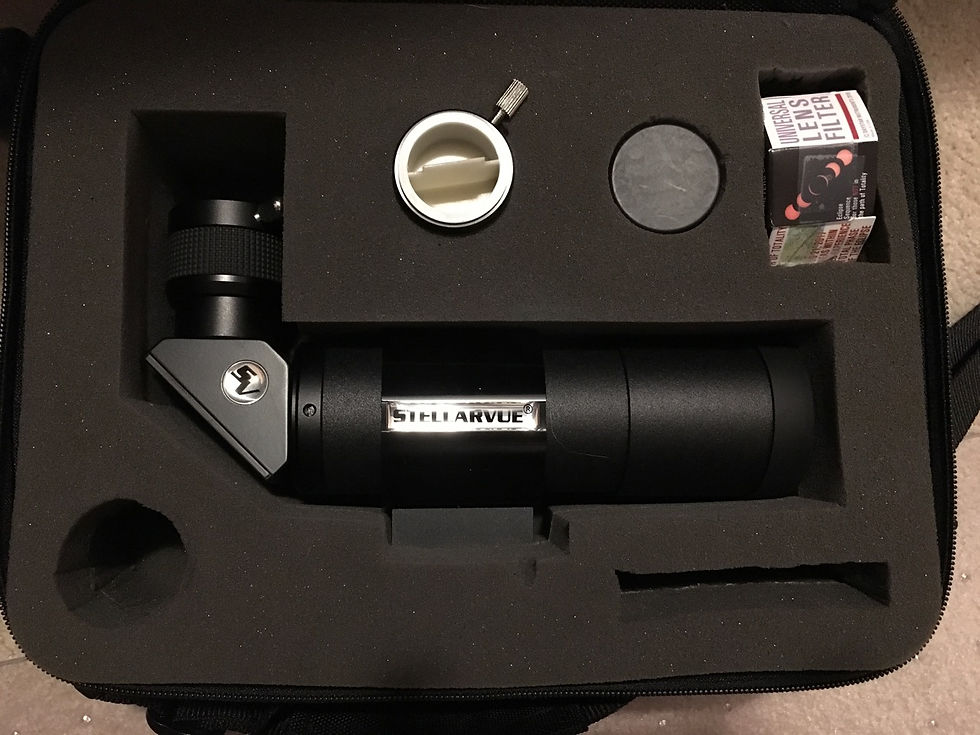Quick Review of the Stellarvue 50mm Little Rascal
- Stephen Strum
- Feb 18, 2019
- 3 min read
Updated: Jan 31, 2021

I picked up the Little Rascal right before the solar eclipse in 2017. While I already had a bunch of gear ready to go for the trip to Missouri to see totality, when practicing using some of the equipment with my seven-year-old son, he was having some difficulty. It can be surprisingly hard to find the sun with a solar filter on in some conditions (particularly with there are just enough high clouds to limit shadows making the initial aim harder) and dealing with reversed images at the eyepiece can further complicate things. I thought of this little scope and had one rushed out to me. I already had a solar filter that was just the right size for it (from a pair of binoculars), and this scope with a photo tripod worked great for solar viewing. The super wide field of view made finding the sun easy, as did the included prism diagonal.

While we had planned to go to St. Joseph, MO to watch the eclipse, satellite data didn't look promising, so we instead headed to Concordia, MO and watched the eclipse from there with a couple dozen other people at a roadside McDonalds along I-70. Numerous people, some as young as 3, were able to get great views of sunspots before totality through the 50 mm scope and had some quick peaks of the corona and solar prominances during totality with the filter removed.

After returning from the eclipse trip, the scope did a lot of work as a quick peak grab-n-go scope on a photo tripod and have been surprised at the views. Stars are pinpoints, and the super-wide field of view (the scope has only a 205mm focal length) is impressive when panning through the milky way, even with the light pollution where we live. Lunar views are surprisingly good too, and even Saturn looked nice and sharp up to about 40x, but it does break down quickly at higher powers. Yes, being a fast achromat there is some false color on the moon, but it is less than I expected, possibly because the scope is only 50 mm. I didn't notice any false color when looking at star fields at low power, but it will show up on bright stars and planets. Still, the false-color is less than I've seen through other achromats.

I love the included case, and since there was some extra space in there, I cut another hole for a third eyepiece (it consists of two spots for eyepieces as shipped), another rectangular hole for the solar filter, and a third narrow rectangular hole for any other accessories or filters I might want to take. The bottom line is that the Little Rascal is a super portable, go-anywhere scope for those times when there isn't space to take anything larger. Also, the combination of the 50 mm scope on a photo-tripod is so light it will get used frequently for those five-minute spur of the moment quick peaks at objects. I've been able to grab quick ten-minute viewing sessions that I would never have been able to do otherwise. This scope gives you the portability of binoculars, but with all the versatility of a telescope. While you probably aren't going to be viewing things at over 100x with this scope, sweeping the milky way with a 6-degree field of view is excellent. You can also see far more stars than at a similar power with similarly sized binoculars because even on a simple photo tripod you have a steadier view than hand-holding binoculars.
This little scope and a few eyepieces make for an excellent little travel and grab-n-go package. Recommended if you want something fun, small, and reasonably low cost that you can toss in any travel bag. A Televue 60 will blow this little guy away, as would the various 60ED scopes on the market, but also cost quite a bit more.
You can buy direct from Stellarvue here: https://www.stellarvue.com/stellarvue-little-rascal-50-mm-f-4-1-refractor-svlr/

Comentários